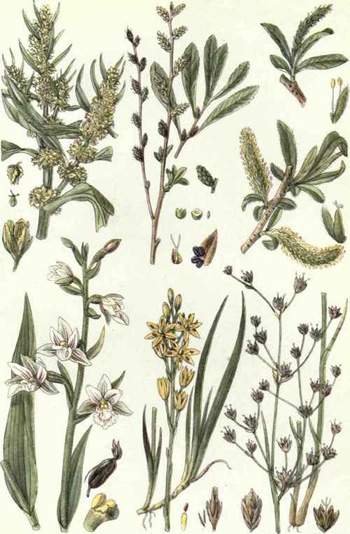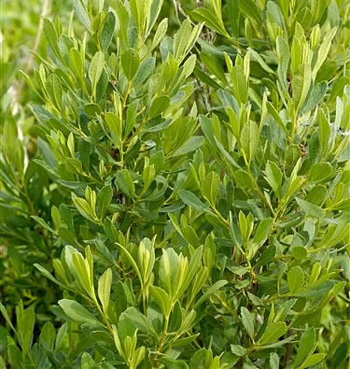Contents:
Common Names | Parts Usually Used | Plant(s) & Culture | Where Found | Medicinal Properties
Legends, Myths and Stories | Uses | Warning | Bibliography
Scientific Names

- Myrica gale
- Myricaceae
- Wax-myrtle family
Common Names
- Sweet gale
Parts Usually Used
Leaves, berries, root bark
Back to Top

Description of Plant(s) and Culture
Bog myrtle is an aromatic deciduous shrub
Back to Top
Where Found
Grows in damp soil, on moors, marshes, swamps, shallow water, and fens. Newfoundland to the mountains of North Carolina; Tennessee to Michigan, Wisconsin, Minnesota.
Back to Top
Medicinal Properties
Bitter tonic, antidepressant, nervine
Back to Top
Legends, Myths and Stories
Norwegians smoke the leaves of this bush with tobacco, which they believe it greatly improves.
The myrtle is called the Greek Mursine because of a young maiden of Athens names Myrsine, who was so beautiful all the lusty lads or brave young men of Athens tenderly loved her, as well as the goddess Pallas or Minerva, who willed her to be always present at tourney, and the tilts, running, vaulting, and other such activities and exercises. After the games, Myrsine was to be the judge and award the garland or crown of honor to the winner. They were so pleased with her judgment that they killed her. As soon as the goddess Minerva found out about it, she caused the sweet myrtle to spring up, and called it Myrsine to honor and in memory of the sweet maiden.
Back to Top
Uses
The leaves, chewed raw or used as a standard infusion, is used as a general tonic and restorative, of special value during bouts of sickness, depression, or strain. It quickly revives the spirit, quickens the mind and strengthens the nerves. Cases of poor memory and mental confusion in old age are successfully treated with Bog myrtle. The branch tea once was used as a diuretic for gonorrhea.
Back to Top
Warning
Essential oil reportedly toxic, inhibits growth of various bacteria.
Do not use without medical supervision.
Back to Top
Bibliography
![]() Eastern/Central Medicinal Plants
Eastern/Central Medicinal Plants, by Steven Foster and James A. Duke., Houghton Mifflin Company, 215 Park Avenue South, New York, NY 10000
![]() The Herbalist Almanac
The Herbalist Almanac, by Clarence Meyer, Meyerbooks, publisher, PO Box 427, Glenwood, Illinois 60425, copyright 1988, fifth printing, 1994
 The Magic of Herbs
The Magic of Herbs, by David Conway, published by Jonathan Cape, Thirty Bedford Square, London, England. (Out of print)
 Old Ways Rediscovered
Old Ways Rediscovered, by Clarence Meyer, Meyerbooks, publisher, PO Box 427, Glenwood, Illinois 60425, published from 1954, print 1988
![]() Webster’s New World Dictionary
Webster’s New World Dictionary, Third College Edition, Victoria Neufeldt, Editor in Chief, New World Dictionaries: A Division of Simon & Schuster, Inc., 15 Columbus Circle, New York, NY 10023
